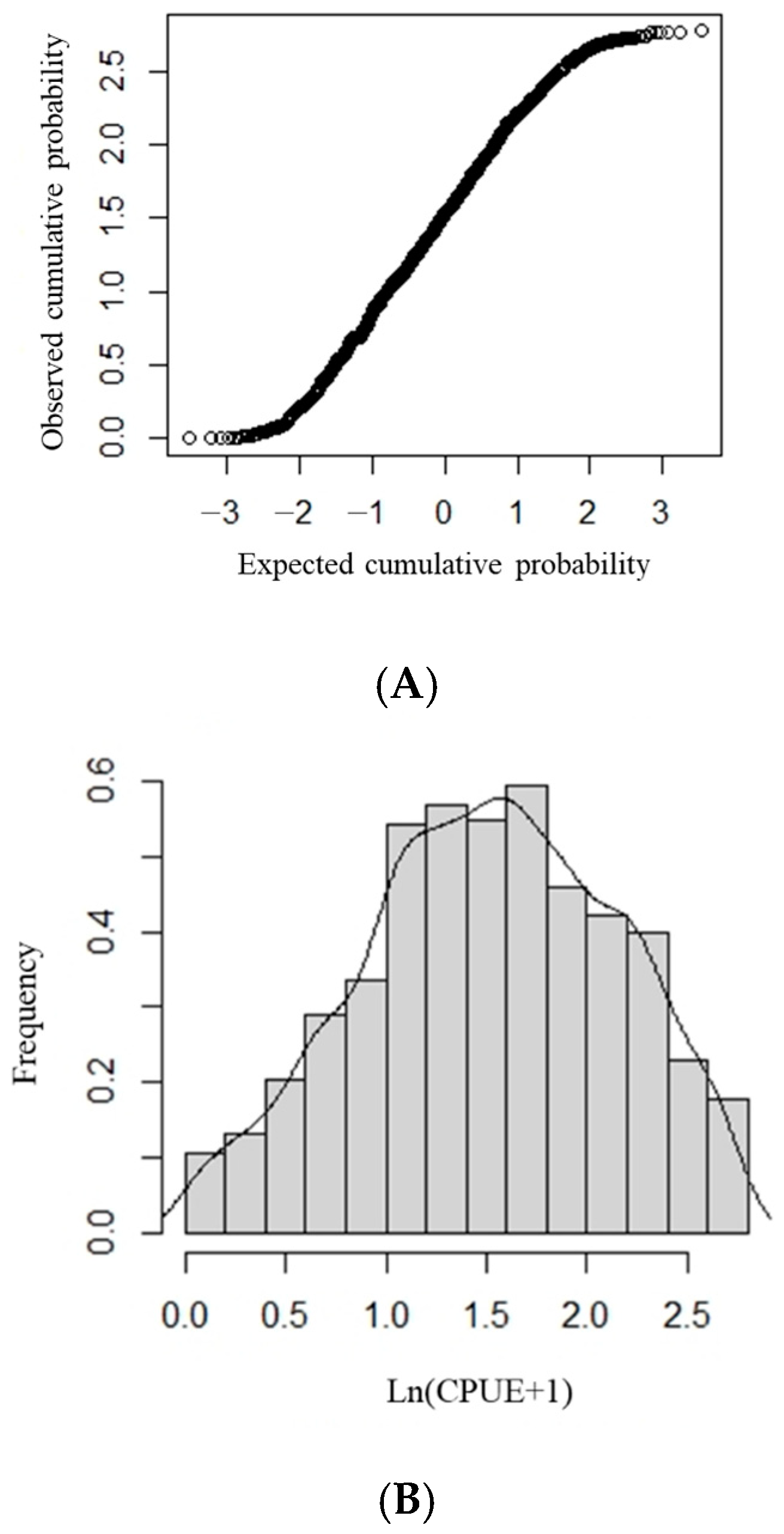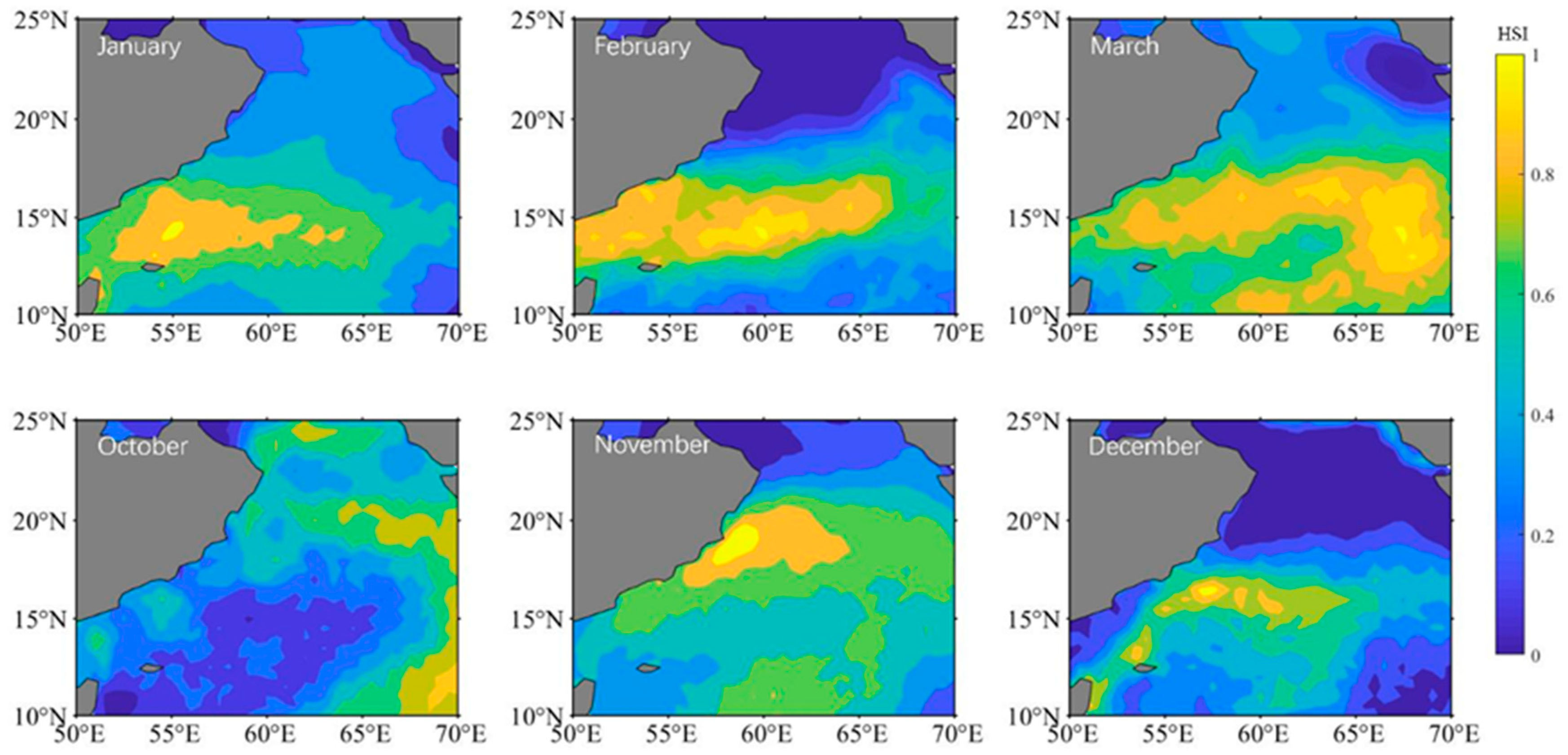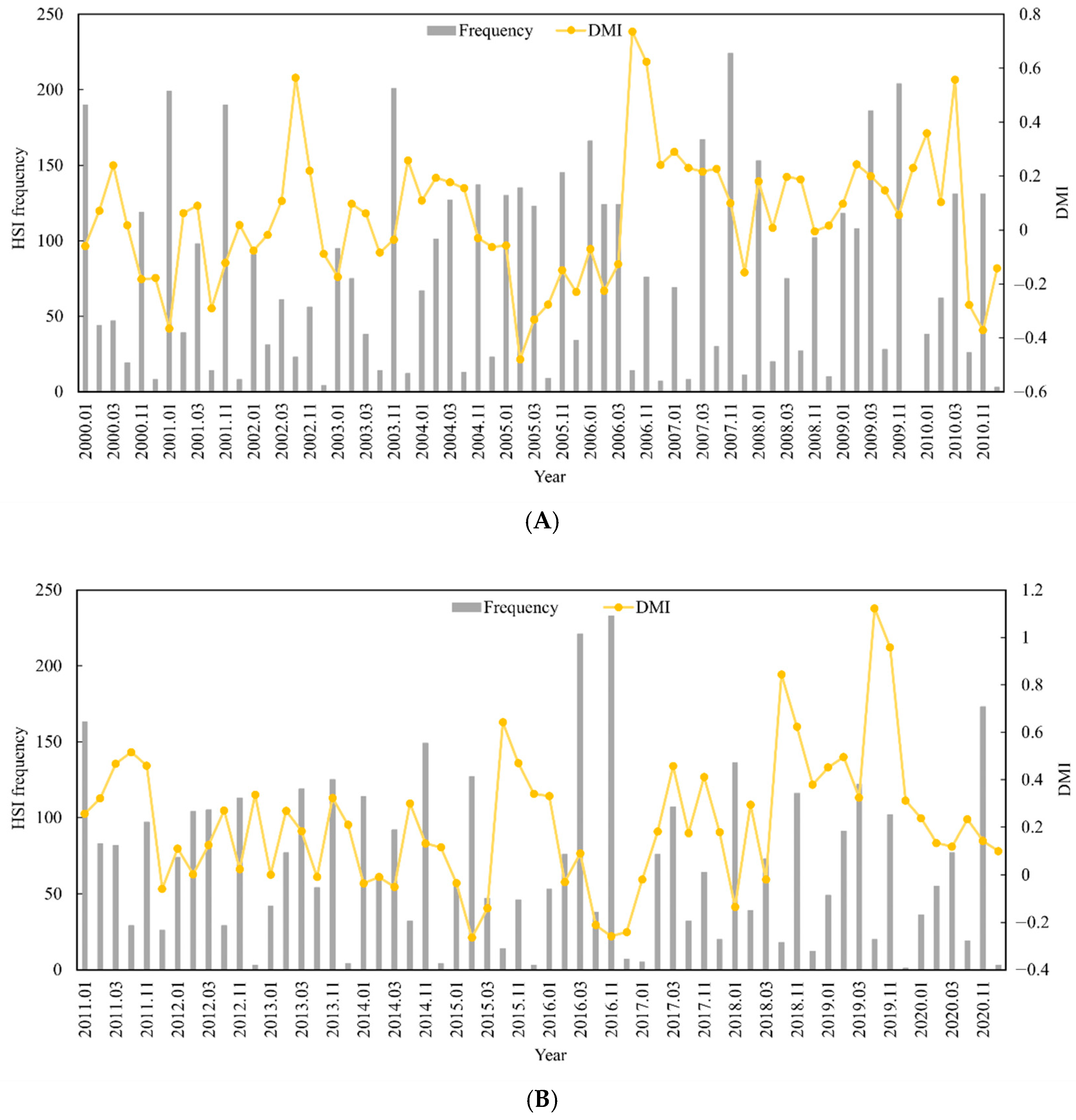The Effects of Climate Change on Sthenoteuthis oualaniensis Habitats in the Northern Indian Ocean
Simple Summary
Abstract
1. Introduction
2. Materials and Methods
2.1. Fisheries, Environmental, and Climatic Index Data
2.2. Catch per Unit Effort
2.3. Generalized Additive Model
2.4. Habitat Suitability Index Model
2.5. Habitat Suitability Index Differences Under Different Climate Events
3. Results
3.1. Generalized Additive Model
3.2. Climatic Habitat Distribution
3.3. Climate Event Statistics
3.4. Habitat Suitability Index at Various Stages
3.5. Temporal and Spatial Changes in Suitable Habitats
4. Discussion
4.1. Distribution of S. oualaniensis Habitats
4.2. Habitat Effects on S. oualaniensis Under Different Climatic Conditions
4.3. Spatial Distribution and Regularity of Habitats
5. Conclusions
Author Contributions
Funding
Institutional Review Board Statement
Informed Consent Statement
Data Availability Statement
Acknowledgments
Conflicts of Interest
References
- Parry, M. Feeding Behavior of Two Ommastrephid Squids Ommastrephes Bartramii and Sthenoteuthis Oualaniensis off Hawaii. Mar. Ecol. Prog. Ser. 2006, 318, 229–235. [Google Scholar] [CrossRef]
- Parry, M. Trophic Variation with Length in Two Ommastrephid Squids, Ommastrephes Bartramii and Sthenoteuthis Oualaniensis. Mar. Biol. 2008, 153, 249–256. [Google Scholar] [CrossRef]
- Jereb, P.; Roper, C.F.E. Cephalopods of the World: An Annotated and Illustrated Catalogue of Cephalopod Species Known to Date; Food and Agriculture Organization of the United Nations: Rome, Italy, 2010; Volume 2, pp. 315–318. [Google Scholar]
- Liu, B.L.; Chen, X.J.; Li, J.H.; Chen, Y. Age, growth and maturation of Sthenoteuthis oualaniensis in the eastern tropical Pacific Ocean by statolith analysis. Mar. Freshw. Res. 2015, 67, 1973–1981. [Google Scholar] [CrossRef]
- Takagi, K.; Kitahara, T.; Suzuki, N.; Mori, J.; Yatsu, A. The age and growth of Sthenoteuthis oualaniensis (Cephalopoda: Ommastrephidae) in the Pacific Ocean. Bull. Mar. Sci. 2002, 71, 1105–1108. [Google Scholar]
- Yu, J.; Hu, Q.; Tang, D.; Zhao, H.; Chen, P. Response of Sthenoteuthis oualaniensis to marine environmental changes in the north-central South China Sea based on satellite and in situ observations. PLoS ONE 2019, 14, e0211474. [Google Scholar] [CrossRef]
- Chen, G.B.; Zhang, J.; Yu, J.; Fan, J.T.; Fang, L.C. Hydroacoustic scattering characteristics and biomass assessment of the purpleback flying squid [Sthenoteuthis oualaniensis, (Lesson, 1830)] from the deepwater area of the South China Sea. J. Appl. Ichthyol. 2013, 29, 1447–1452. [Google Scholar] [CrossRef]
- Rodhouse, P.G.; Pierce, G.J.; Nichols, O.C.; Sauer, W.H.; Arkhipkin, A.I.; Laptikhovsky, V.V.; Lipiński, M.R.; Ramos, J.E.; Gras, M.; Kidokoro, H.; et al. Environmental effects on cephalopod population dynamics: Implications for management of fisheries. Adv. Mar. Biol. 2014, 67, 99–233. [Google Scholar]
- Anderson, C.I.; Rodhouse, P.G. Life Cycles, Oceanography and Variability: Ommastrephid Squid in Variable Oceanographic Environments. Fish. Res. 2001, 54, 133–143. [Google Scholar] [CrossRef]
- Yu, W.; Chen, X.; Yi, Q.; Chen, Y.; Zhang, Y. Variability of suitable habitat of western winter-spring cohort for neon flying squid in the Northwest Pacific under anomalous environments. PLoS ONE 2015, 10, e0122997. [Google Scholar] [CrossRef] [PubMed]
- Postuma, F.A.; Gasalla, M.A. On the Relationship between Squid and the Environment: Artisanal Jigging for Loligo Plei at São Sebastião Island (24° S), Southeastern Brazil. ICES J. Mar. Sci. 2010, 67, 1353–1362. [Google Scholar] [CrossRef][Green Version]
- Pang, Y.; Tian, Y.; Fu, C.; Wang, B.; Li, J.; Ren, Y.; Wan, R. Variability of coastal cephalopods in overexploited China Seas under climate change with implications on fisheries management. Fish. Res. 2018, 208, 22–23. [Google Scholar] [CrossRef]
- Yu, W.; Zhang, Y.; Chen, X.; Yi, Q.; Qian, W. Response of winter cohort abundance of Japanese common squid Todarodes pacificus to the ENSO events. Acta Oceanol. Sin. 2018, 37, 61–71. [Google Scholar] [CrossRef]
- Feng, Z.; Yu, W.; Chen, X. Concurrent habitat fluctuations of two economically important marine species in the Southeast Pacific Ocean off Chile in relation to ENSO perturbations. Fish. Oceanogr. 2021, 31, 123–134. [Google Scholar] [CrossRef]
- Chang, K.Y.; Chen, C.S.; Wang, H.Y.; Kuo, C.L.; Chiu, T.S. The Antarctic Oscillation index as an environmental parameter for predicting catches of the Argentine shortfin squid (Illex argentinus Cephalopoda: Ommastrephidae) in southwest Atlantic waters. Fish. Bull. 2015, 113, 202–212. [Google Scholar] [CrossRef]
- Liu, H.W.; Yu, W.; Chen, X.J.; Wang, J.T.; Zhang, Z. Influence of Antarctic sea ice variation on abundance and spatial distribution of Argentine shortfin squid Illex argentinus in the southwest Atlantic Ocean. J. Fish. China 2021, 45, 187–199. [Google Scholar]
- Shi, W.; Wang, M.H. A biological Indian Ocean Dipole event in 2019. Sci. Rep. 2021, 11, 2452. [Google Scholar] [CrossRef] [PubMed]
- Sheinbaum, J. Current theories on El Niño-Southern Oscillation: A review. Geofís. Int. 2003, 42, 291–305. [Google Scholar] [CrossRef]
- Saji, N.H.; Goswami, B.N.; Vinayachandran, P.N.; Yamagata, T. A dipole mode in the tropical Indian Ocean. Nature 1999, 401, 360–363. [Google Scholar] [CrossRef] [PubMed]
- Li, C.Y.; Mu, M.Q.; Pan, J. Indian Ocean temperature dipole and SSTA in the equatorial Pacific Ocean. Chin. Sci. Bull. 2002, 47, 236–239. [Google Scholar] [CrossRef]
- Zhang, L.; Wang, G.; Newman, M.; Han, W. Interannual to decadal variability of tropical Indian Ocean sea surface temperature: Pacific influence versus local internal variability. J. Climate 2021, 34, 2669–2684. [Google Scholar] [CrossRef]
- Webster, P.J.; Moore, A.M.; Loschnigg, J.P.; Leben, R.R. Coupled ocean-atmosphere dynamics in the Indian Ocean during 1997–98. Nature 1999, 401, 356–360. [Google Scholar] [CrossRef] [PubMed]
- Zhao, Y.; Chen, Y.; Wang, F.; Bai, X.; Wu, A. Two modes of dipole events in tropical Indian Ocean. Sci. China Ser. D Earth Sci. 2009, 52, 369–381. [Google Scholar] [CrossRef]
- Fischer, A.S.; Terray, P.; Guilyardi, E.; Gualdi, S.; Delecluse, P. Two independent triggers for the Indian Dipole/zonal mode in a coupled GCM. J. Climate 2005, 18, 3428–3448. [Google Scholar] [CrossRef]
- Yu, J.Y.; Lau, K.M. Contrasting Indian Ocean SST variability with and without ENSO influence: A coupled atmosphere-ocean GCM study. Meteorol. Atmos. Phys. 2004, 90, 179–191. [Google Scholar] [CrossRef]
- Saji, N.H.; Ambrizzi, T.; Ferraz, S.E.T. Indian Ocean Dipole mode events and austral surface air temperature anomalies. Dyn. Atmos. Oceans 2005, 39, 87–101. [Google Scholar] [CrossRef]
- Lumban-Gaol, J.; Siswanto, E.; Mahapatra, K.; Natih, N.M.N.; Nurjaya, I.W.; Hartanto, M.T.; Maulana, E.; Adrianto, L.; Rachman, H.A.; Osawa, T.; et al. Impact of the Strong Downwelling (Upwelling) on Small Pelagic Fish Production during the 2016 (2019) Negative (Positive) Indian Ocean Dipole Events in the Eastern Indian Ocean off Java. Climate 2021, 9, 29. [Google Scholar] [CrossRef]
- Vecchione, M. Extraordinary abundance of squid paralarvae in the tropical eastern Pacific Ocean during El Niño of 1987. Fish. Bull. 1999, 97, 1025–1030. [Google Scholar]
- Sajikumar, K.K.; Ragesh, N.; Venkatesan, V.; Koya, K.P.; Sasikumar, G.; Kripa, V.; Mohamed, K.S. Morphological development and distribution of paralarvae and juveniles of purpleback flying squid S thenoteuthis oualaniensis (Ommastrephidae), in South-eastern Arabian Sea. Vie Milieu 2018, 68, 75–86. [Google Scholar]
- Wen, J.; Lu, X.Y.; Chen, X.J.; Yu, W. Predicting the habitat hot spots of winter-spring cohort of Ommastrephes bartramii in the northwest Pacific Ocean based on the sea surface temperature and photosynthetically active radiation. J. Shanghai Ocean Univ. 2019, 28, 456–463. [Google Scholar]
- Yu, W.; Chen, X.; Yi, Q.; Tian, S. A Review of Interaction between Neon Flying Squid (Ommastrephes Bartramii) and Oceanographic Variability in the North Pacific Ocean. J. Ocean Univ. China 2015, 14, 739–748. [Google Scholar] [CrossRef]
- Tian, S.Q.; Chen, X.J. Impacts of different calculating methods for nominal CPUE on CPUE standardization. J. Shanghai Ocean Univ. 2010, 19, 240–246. [Google Scholar]
- Li, M.; Zhang, C.; Xu, B.; Xue, Y.; Ren, Y. A comparison of GAM and GWR in modelling spatial distribution of Japanese mantis shrimp (Oratosquilla oratoria) in coastal waters. Est. Coast. Shelf Sci. 2020, 244, 106928. [Google Scholar] [CrossRef]
- Venables, W.N.; Dichmont, C.M. GLMs, GAMs and GLMMs: An overview of theory for applications in fisheries research. Fish. Res. 2004, 70, 319–337. [Google Scholar] [CrossRef]
- Maury, O.; Gascuel, D.; Marsac, F.; Fonteneau, A.; Rosa, A.L.D. Hierarchical interpretation of nonlinear relationships linking yellowfin tuna (Thunnus albacares) distribution to the environment in the Atlantic Ocean. Can. J. Fish. Aquat. Sci. 2001, 58, 458–469. [Google Scholar] [CrossRef]
- Chen, X.J.; Gao, F.; Guan, W.J.; Lei, L.; Wang, J. Review of fishery forecasting technology and its models. J. Fish. China 2013, 37, 1270–1280. [Google Scholar] [CrossRef]
- Yu, W.; Yi, Q.; Chen, X.; Chen, Y. Modelling the effects of climate variability on habitat suitability of jumbo flying squid, Dosidicus gigas, in the Southeast Pacific Ocean off Peru. ICES J. Mar. Sci. 2016, 73, 239–249. [Google Scholar] [CrossRef]
- Yen, K.W.; Wang, G.; Lu, H.J. Evaluating habitat suitability and relative abundance of skipjack (Katsuwonus pelamis) in the Western and Central Pacific during various El Niño events. Ocean Coast. Manag. 2017, 139, 153–160. [Google Scholar] [CrossRef]
- Lauver, C.L.; Busby, W.H.; Whistler, J.L. Testing aGIS model of habitat suitability for a declining grasslandbird. Environ. Manag. 2002, 30, 88–97. [Google Scholar] [CrossRef] [PubMed]
- Yu, W.; Chen, X.; Zhang, Y. Seasonal habitat patterns of jumbo flying squid Dosidicus gigas off Peruvian waters. J. Mar. Systems. 2019, 194, 41–51. [Google Scholar] [CrossRef]
- Tokinaga, H.; Tanimoto, Y. Seasonal transition of SST anomalies in the tropical Indian ocean during El Nino and Indian Ocean dipole years. J. Meteorol. Soc. Jpn. 2004, 82, 1007–1018. [Google Scholar] [CrossRef]
- Lu, B.; Ren, H.L. What caused the extreme Indian Ocean Dipole event in 2019? Geophys. Res. Lett. 2020, 47, e2020GL087768. [Google Scholar] [CrossRef]
- Mammel, M.; Lee, M.A.; Naimullah, M.; Liao, C.H.; Wang, Y.C.; Semedi, B. Habitat changes and catch rate variability for greater amberjack in the Taiwan Strait: The effects of El Niño-southern oscillation events. Front. Mar. Sci. 2023, 10, 1024669. [Google Scholar] [CrossRef]
- Yu, W.; Guo, A.; Zhang, Y.; Chen, X.; Qian, W.; Li, Y. Climate-induced habitat suitability variations of chub mackerel Scomber japonicus in the East China Sea. Fish. Res. 2018, 207, 63–73. [Google Scholar] [CrossRef]
- Zhou, W.F.; Xu, H.Y.; Li, A.Z.; Cui, X.S.; Chen, G.B. Comparison of habitat suitability index models for purpleback flying squid (Sthenoteuthis oualaniensis) in the open South China sea. Appl. Ecol. Environ. Res. 2019, 17, 4903–4913. [Google Scholar] [CrossRef]
- Caballero-Alfonso, A.M.; Ganzedo, U.; Trujillo-Santana, A.; Polanco, J.; del Pino, A.S.; Ibarra-Berastegi, G.; Castro-Hernández, J.J. The role of climatic variability on the short-term fluctuations of octopus captures at the Canary Islands. Fish. Res. 2010, 102, 258–265. [Google Scholar] [CrossRef]
- Wiggert, J.D.; Jones, B.H.; Dickey, T.D.; Brink, K.H.; Weller, R.A.; Marra, J.; Codispoti, L.A. The northeast monsoon’s impact on mixing, phytoplankton biomass and nutrient cycling in the Arabian Sea. Deep Sea Res. Part II Top. Stud. Oceanogr. 2000, 47, 1353–1385. [Google Scholar] [CrossRef]
- Hood, R.R.; Beckley, L.E.; Wiggert, J.D. Biogeochemical and Ecological Impacts of Boundary Currents in the Indian Ocean. Prog. Oceanogr. 2017, 156, 290–325. [Google Scholar] [CrossRef]
- Zhao, C.; Shen, C.; Bakun, A.; Yan, Y.; Kang, B. Purpleback flying squid Sthenoteuthis oualaniensis in the South China Sea: Growth, resources and association with the environment. Water 2020, 13, 65. [Google Scholar] [CrossRef]
- Qian, M.T.; Gong, J.W.; Fan, J.T.; Yu, W.; Chen, X.J.; Qan, W.G. Variations in the abundance and spatial distribution of Ommastrephes bartramii in the Northwest Pacific Ocean based on photosynthetic active radiation. Haiyang Xuebao 2020, 42, 44–53. [Google Scholar]
- Yuan, D.; Han, W. Roles of equatorial waves and western boundary reflection in the seasonal circulation of the equatorial Indian Ocean. J. Phys. Oceanogr. 2006, 36, 930–944. [Google Scholar] [CrossRef]
- Chen, G.; Li, Y.; Xie, Q.; Wang, D.X. Origins of eddy kinetic energy in the Bay of Bengal. J. Geophys. Res. Ocean. 2018, 123, 2097–2115. [Google Scholar] [CrossRef]
- Chen, G.X. The ocean wave bridge linking the circulation in the tropical Eastern Indian Ocean. Adv. Earth Sci. 2022, 37, 80–86. [Google Scholar]
- Du, Y.; Zhang, L.Y.; Zhang, Y.H. Review of the tropical gyre in the Indian Ocean with its impact on heat and salt transport and regional climate modes. Adv. Earth Sci. 2019, 34, 243–254. [Google Scholar]
- Han, W.; McCreary, J.P., Jr. Modeling salinity distributions in the Indian Ocean. J. Geophys. Res. Ocean. 2001, 106, 859–877. [Google Scholar] [CrossRef]
- Alabia, I.D.; Saitoh, S.I.; Igarashi, H.; Ishikawa, Y.; Usui, N.; Kamachi, M.; Awaji, T.; Seito, M. Future projected impacts of ocean warming to potential squid habitat in western and central North Pacific. ICES J. Mar. Sci. 2016, 73, 1343–1356. [Google Scholar] [CrossRef]
- Ichii, T.; Mahapatra, K.; Sakai, M.; Wakabayashi, T.; Okamura, H.; Igarashi, H.; Inagake, D.; Okada, Y. Changes in abundance of the neon flying squid Ommastrephes bartramii in relation to climate change in the central North Pacific Ocean. Mar. Ecol. Prog. Ser. 2011, 441, 151–164. [Google Scholar] [CrossRef]
- Fan, J.; Chen, Z.; Feng, X.; Yu, W. Climate-related changes in seasonal habitat pattern of Sthenoteuthis oualaniensis in the South China Sea. Ecosyst. Health Sustain. 2021, 7, 1926338. [Google Scholar] [CrossRef]
- Li, T.; Zhang, Y.; Lu, E.; Wang, D. Relative role of dynamic and thermodynamic processes in the development of the Indian Ocean dipole: An OGCM diagnosis. Geophys. Res. Lett. 2002, 29, 2110. [Google Scholar] [CrossRef]
- Lu, B.; Ren, H.L.; Scaife, A.A.; Wu, J.; Dunstone, N.; Smith, D.; Wan, J.; Eade, R.; MacLachlan, C.; Gordon, M. An extreme negative Indian Ocean Dipole event in 2016: Dynamics and predictability. Clim. Dyn. 2018, 51, 89–100. [Google Scholar] [CrossRef]
- Cai, W.; Yang, K.; Wu, L.; Huang, G.; Santoso, A.; Ng, B.; Wang, G.; Yamagata, T. Opposite response of strong and moderate positive Indian Ocean Dipole to global warming. Nat. Clim. Change 2021, 11, 27–32. [Google Scholar] [CrossRef]
- Iskandar, I.; Lestari, D.O.; Utari, P.A.; Khakim, M.Y.N.; Poerwono, P.; Setiabudidaya, D. Evolution and impact of the 2016 negative Indian Ocean Dipole. IOP Conf. Ser. J. Phys. Conf. Ser. 2018, 985, 012017. [Google Scholar] [CrossRef]
- Xing, H.B.; Chen, S.; Xu, K.; Wang, W.Q. Interannual variability of meridional heat transport and its mechanism in the Indian Ocean during monsoon transitions. Haiyang Xuebao 2021, 43, 26–37. [Google Scholar]
- Yu, L.S.; Jin, X.Z.; Weller, R.A. Annual, seasonal, and interannual variability of air-sea heat fluxes in the Indian Ocean. J. Clim. 2007, 20, 3190–3209. [Google Scholar] [CrossRef]
- Han, W.; Vialard, J.; McPhaden, M.J.; Lee, T.; Masumoto, Y.; Feng, M.; De Ruijter, W.P. Indian Ocean decadal variability: A review. Bull. Am. Meteorol. Soc. 2014, 95, 1679–1703. [Google Scholar] [CrossRef]






| Explanatory Variable | DF | F | p | R2 | AIC | Cumulative Interpretation Deviation |
|---|---|---|---|---|---|---|
| Null | - | - | - | - | - | - |
| +year | 1.957 | 69.270 | <0.01 | 0.052 | 5439.061 | 5.6% |
| +month | 3.713 | 28.550 | <0.01 | 0.090 | 5336.457 | 10.82% |
| +latitude | 3.485 | 37.540 | <0.01 | 0.138 | 5199.324 | 15.76% |
| +longitude | 2.419 | 11.820 | <0.01 | 0.149 | 5166.385 | 16.96% |
| +SST | 1.856 | 6.005 | <0.01 | 0.150 | 5165.758 | 20.9% |
| +WS | 2.559 | 7.270 | <0.01 | 0.155 | 5152.522 | 21.5% |
| +PAR | - | - | <0.01 | 0.210 | 4979.165 | 21.6% |
Disclaimer/Publisher’s Note: The statements, opinions and data contained in all publications are solely those of the individual author(s) and contributor(s) and not of MDPI and/or the editor(s). MDPI and/or the editor(s) disclaim responsibility for any injury to people or property resulting from any ideas, methods, instructions or products referred to in the content. |
© 2025 by the authors. Licensee MDPI, Basel, Switzerland. This article is an open access article distributed under the terms and conditions of the Creative Commons Attribution (CC BY) license (https://creativecommons.org/licenses/by/4.0/).
Share and Cite
Wen, L.; Zhang, H.; Fang, Z.; Chen, X. The Effects of Climate Change on Sthenoteuthis oualaniensis Habitats in the Northern Indian Ocean. Animals 2025, 15, 573. https://doi.org/10.3390/ani15040573
Wen L, Zhang H, Fang Z, Chen X. The Effects of Climate Change on Sthenoteuthis oualaniensis Habitats in the Northern Indian Ocean. Animals. 2025; 15(4):573. https://doi.org/10.3390/ani15040573
Chicago/Turabian StyleWen, Lihong, Heng Zhang, Zhou Fang, and Xinjun Chen. 2025. "The Effects of Climate Change on Sthenoteuthis oualaniensis Habitats in the Northern Indian Ocean" Animals 15, no. 4: 573. https://doi.org/10.3390/ani15040573
APA StyleWen, L., Zhang, H., Fang, Z., & Chen, X. (2025). The Effects of Climate Change on Sthenoteuthis oualaniensis Habitats in the Northern Indian Ocean. Animals, 15(4), 573. https://doi.org/10.3390/ani15040573








